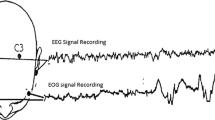Abstract
The objective of our ongoing work is to develop an algorithm for detecting and eliminating artifacts from the EEG polysomnographic signals thus helping practitioners in their diagnostic. The EEG signals play an important role in the identification of brain activity and thus in the sleep stage classification. However, it is well known that the recorded EEG signals may be contaminated with artifacts that affect the analysis of EEG signal. Our short paper proposes methods for detecting and eliminating non-physiological and physiological artifacts using filtering for the first and a mixed method based on ICA and wavelets for the second.
Access this chapter
Tax calculation will be finalised at checkout
Purchases are for personal use only
Similar content being viewed by others
References
Devuyst, S., et. al.: Automatic sleep spindles detection—overview and development of a standard proposal assessment method. In: Annual International Conference of the IEEE Engineering in Medicine and Biology Society. IEEE (2011)
Rechtschaffen, A., Kales, A. (eds.): A manual of standardized terminology, techniques and scoring system for skip stages of human subjects. Brain Information Service/Brain Research Institute, Washington, DC (1968)
Sweeney, K.T., Ward, T.E., Mcloone, S.F.: Artifact removal in physiological signals—practices and possibilities. IEEE Trans. Inf Technol. Biomed. 16(3), 488–500 (2012)
Dora, C., Biswal, P.K.: Automated detection of nonphysiological artifacts in polysomnographic EEG using conventional signal processing techniques. In: Region 10 Conference, TENCON 2017, pp. 1568–1572. IEEE (2017)
Schlögl, A., Keinrath, C., Zimmermann, D., et al.: A fully automated correction method of EOG artifacts in EEG recordings. Clin. Neurophysiol. 118(1), 98–104 (2007)
Winkler, I., Debener, S., Müller, K.R., Tangermann, M.: On the influence of high-pass filtering on ICA-based artifact reduction in EEG-ERP. In: 2015 37th Annual International Conference of the IEEE Engineering in Medicine and Biology Society (EMBC), pp. 4101–4105 (2015)
Mannan, M.M.N., Jeong, M.Y., Kamran, M.A.: Hybrid ICA—regression: automatic identification and removal of ocular artifacts from electroencephalographic signals. Front. Hum. Neurosci. 10, 193 (2016)
Urigüen, J.A., Garcia-Zapirain, B.: EEG artifact removal—state-of-the-art and guidelines. J. Neural Eng. 12(3), 031001 (2015)
Author information
Authors and Affiliations
Corresponding author
Editor information
Editors and Affiliations
Rights and permissions
Copyright information
© 2020 Springer Nature Switzerland AG
About this paper
Cite this paper
Sekkal, R.N., Bereksi-Reguig, F., Dib, N., Ruiz-Fernandez, D. (2020). An Approach to Detecting and Eliminating Artifacts from the Sleep EEG Signals. In: Rojas, I., Valenzuela, O., Rojas, F., Herrera, L., Ortuño, F. (eds) Bioinformatics and Biomedical Engineering. IWBBIO 2020. Lecture Notes in Computer Science(), vol 12108. Springer, Cham. https://doi.org/10.1007/978-3-030-45385-5_14
Download citation
DOI: https://doi.org/10.1007/978-3-030-45385-5_14
Published:
Publisher Name: Springer, Cham
Print ISBN: 978-3-030-45384-8
Online ISBN: 978-3-030-45385-5
eBook Packages: Computer ScienceComputer Science (R0)




